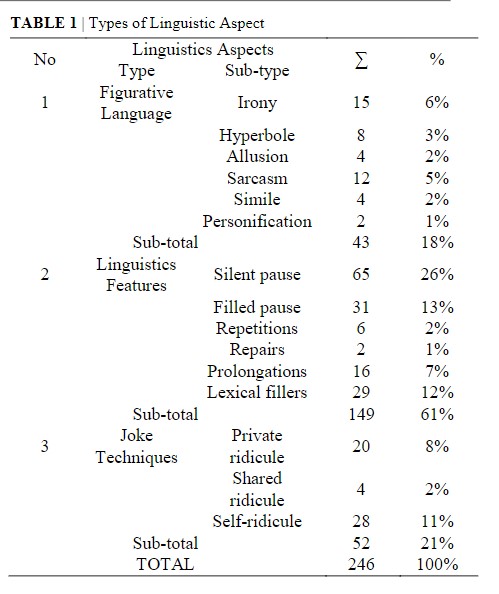Humor and identity in the performance of a stand-up comedian with disability
DOI:
https://doi.org/10.21070/jees.v7i2.1685Keywords:
stand-up comedy, linguistics, disability, humor, identityAbstract
Being a stand-up comedian with medical issue requires the ability to apply certain techniques to create humor when performing stand-up comedy. Josh Blue (JB) is one of those well-known stand-up comedians diagnosed with cerebral palsy. This study aims to investigate the linguistics aspects applied by JB in delivering his jokes and how these aspects relate to identity JB wants to present. This research employed a qualitative descriptive method to analyze the data. The results reveal that JB uses irony in his stand-up comedy. In terms of linguistic features, JB mostly applies silent pause, while in joke technique JB applies self-ridicule. These findings suggest that the linguistics aspects used by JB present that disability can be a special identity that affects people’s perception and their ways of interaction with other people. JB linked each of his experience of being disabled by wrapping it well as his joke technique. JB has privilege in processing his disability into a primacy in joke technique without sounding condescending and even sarcastic.
HIGHLIGHTS:
- Irony is the language feature commonly used by Josh Blue as he often shares his experiences implicitly.
- Ridicule is the most dominant joke technique used by Josh Blue since most topics that he shares are about his condition of being disabled.
- The linguistics aspects used by Josh Blue demonstrates that disability identity can be a special phenomenon that affects people’s perception and their ways of interaction with other people.
Downloads
References
Abrams, M. H. (1999). A glossary of literary terms (Seventh Ed). Boston, Massachusetts: Heinle & Heinle.
Abujbarah, K. (2019). Laughing back: A phenomenological study of disability humor using culturally responsive methodologies. ProQuest Dissertations and Theses, December, 181.
Arfani, S., & Damayanti, S. C. (2019). The use of figurative langugae in Katy Perry song. Journal of English Language and Literature (JELL), 4(02), 19–27. https://doi.org/10.37110/jell.v4i02.76
Arifah, K. (2016). Figurative Language analysis in five John Legend’s Song. Maulana Malik Ibrahim State Islamic University of Malang.
Armuzad, A. F. (2017). Figurative language used in sports rubric in the Jakarta Post Newspaper. State Islamic University Sunan Ampel Surabaya.
Badara, A. (2018). Stand-up comedy humor discourse in local perspective in Indonesia. International Journal of Applied Linguistics and English Literature, 7(7), 222. https://doi.org/10.7575/aiac.ijalel.v.7n.7p.222
Bamgbose, G. A. (2019). Humour strategies, linguistic and multimodal devices in two Nigerian situation comedies, Jenifa’s Diary and Professor Johnbull. University of Ibadan.
Burke, P. J., & Stets, J. E. (2009). Identity theory. Oxford University Press.
Dylewski, R. (2021). Dissecting the word: The use of the lexeme shit in selected performances of comedian Dave Chappelle’s stand-up routine. Studia Anglica Posnaniensia, 56(S1), 511–550. https://doi.org/10.2478/stap-2021-0007
Dynel, M. (2009). Beyond a joke: Types of conversational humour. Linguistics and Language Compass, 3(5), 1284–1299. https://doi.org/10.1111/j.1749-818X.2009.00152.x
Fadlilah, U. (2022). Humor in stand-up comedy: Exploring Chris Rock’s identity. Universitas Islam Negeri Maulana Malik Ibrahim Malang.
Handika, D., Syarif, H., & Marlina, L. (2019). An analysis of minor figurative language used in stand-up comedy performed by Hasan Minhaj entitled Homecoming King. English Language and Literature, 8(4). https://doi.org/10.24036/ell.v8i4.106779
Heidari-Shahreza, M. A., & Masaeli, B. (2017). A linguistic analysis of para-jokes and meta-jokes in Persian Verbal Humor. Journal of Applied Linguistics and Language Research, 4, 109–115. Available at: www.jallr.com.
Lockyer, S. (2015). From comedy targets to comedy-makers: Disability and comedy in live performance. Disability and Society, 30(9), 1397–1412. https://doi.org/10.1080/09687599.2015.1106402
MacGregor, L. J. (2008). Disfluencies affect language comprehension: Evidence from event-related potentials and recognition memory. Language Sciences. http://hdl.handle.net/1842/3311
Nassaji, H. (2015). Qualitative and descriptive research: Data type versus data analysis. Language Teaching Research, 19(2), 129–132. https://doi.org/10.1177/1362168815572747
Putri, M. W., Oktoma, E., & Nursyamsu, R. (2016). Figurative language in English stand-up comedy. English Review: Journal of English Education, 5(1), 115. https://doi.org/10.25134/erjee.v5i1.396
Rostami, F., Yousefi, M. H., & Amini, D. (2021). A qualitative study on identity construction among teachers working with students with disabilities. International Journal of Multicultural Education, 23(2), 88–106. https://doi.org/10.18251/ijme.v23i2.2611
Schwarz, J. (2010). Linguistic aspects of verbal humor in stand-up comedy. In Universität des Saarlandes. Universität des Saarlandes.
Seizer, S. (2011). On the uses of obscenity in live stand-up comedy. Anthropological Quarterly, 84(1), 209–234. https://doi.org/10.1353/anq.2011.0001
Setyaningsih, N. (2013). Ethnic stereotypes in stand-up comedy. Prosiding the 5th International Conference on Indonesian studies: “Ethnicity and Globalization,” 144–157.
Setyaningsih, N. (2014). I Tweet, Therefore I Am: Indexing Identity through Language Choice on Twitter Posts of @AsliSemarang Account. Proceedings of KOLITA 12: Konferensi Linguistik Tahunan Atma Jaya 12, 147–151.
Sulistyo, P. B. (2019). Metode Penelitian Kualitatif [Qualitative Research Method]. In Metode Penelitian Ilmiah [Scientific Research Method]. Universitas Mercu Buana.
Sutrisno, B., & Putri, A. (2017). A figurative language analysis of song lyric ‘Mirrors’ by Justin Timberlake. Journal of English and Literature (JELL), 02, 117–138.
Utami, I. I. (2018). Strategi Humor pada Acara Stand Up Comedy [Humor Strategy in Stand-Up Comedy Program]. Adabiyyāt: Jurnal Bahasa dan Sastra, 2(2), 219. https://doi.org/10.14421/ajbs.2018.02204
Yuniar, D. (2013). Ya as discourse marker: Indonesian stand – up comedy strategy in producing laughter. International Journal of Applied Linguistics and English Literature, 2(6), 103–110. https://doi.org/10.7575/aiac.ijalel.v.2n.6p.103

Published
How to Cite
Issue
Section
License
Copyright (c) 2022 Nirel Angwen Wisley Tan, Mike Pratiwi Wijaya, Nina Setyaningsih

This work is licensed under a Creative Commons Attribution 4.0 International License.







